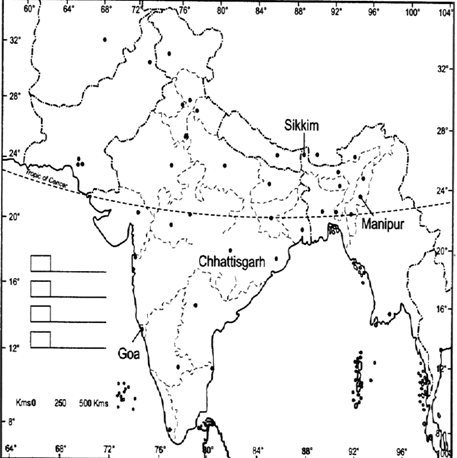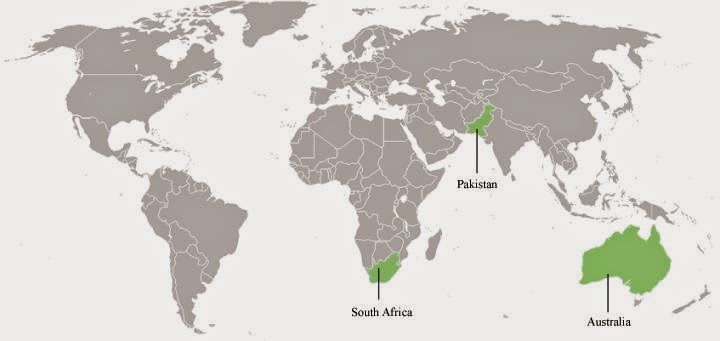NCERT Solutions for Chapter 2 Federalism Class 10 Civics
Book Solutions1
Locate the following States on a blank outline political map of India:
Manipur, Sikkim, Chhattisgarh and Goa.
Answer

Exercises
Page Number 27
2
Identify and shade three federal countries (other than India) on a blank outline political map of the world.
Exercises
Page Number 27
3
Point out one feature in the practice of federalism in India that is similar to and one feature that is different from that of Belgium.
Answer
• Similarity: Like Belgium, India also has regional and cultural differences, and many languages are spoken. So no one language is made the national language and equal importance is given to different cultures and languages.
• Difference: Though in India there are central and state governments that share power, but the centre is made stronger than the states. It has more powers. In Belgium, the state governments are not subordinate to the central government.
Exercises
Page Number 27
4
What is the main difference between a federal form of government and a unitary one? Explain with an example.
Answer
• In Federal form of government, the power is divided between the central authority and various constituent units of the country. For example, in India, power is divided between the government at the Centre and the various State governments.
• In the unitary system, there is only one level of govenment or if states or subdivisions are there, they are subordinate to the Central government. For example, in Sri Lanka, the national government has all the powers.
Exercises
Page Number 27
5
State any two differences between the local government before and after the Constitutional amendment in 1992.
Answer
The following changes took place as a result of the amendment of 1992 :
(i) Before 1992, local elections were controlled by the state and not held regularly but after 1992, an independent State Election Commission is responsible to conduct elections regularly and is made mandatory to hold regular elections after every 5 years to local government bodies.
(ii) Local governments did not have any powers or resources of their own before 1992 but after 1992, the State governments are required to share some powers and revenue with local government bodies.
Exercises
Page Number 27
6
Fill in the blanks:
Since the United States is a ___________________ type of federation, all the constituent States have equal powers and States are ______________vis-à-vis the federal government. But India is a _____________________ type of federation and some States have more power than others. In India, the ____________ government has more powers.
Answer
coming together, strong, holding together, Central.
Exercises
Page Number 27
7
Here are three reactions to the language policy followed in India. Give an argument and an example to support any of these positions.
Sangeeta: The policy of accommodation has strengthened national unity.
Arman: Language-based States have divided us by making everyone conscious of their language.
Harish: This policy has only helped to consolidate the dominance of English over all other languages.
Answer
I agree with Sangeeta. If the policy of accommodation was not followed, and states were not created on linguistic basis, there would have been further partition of India. For example, imposition of Hindi as the national language would have led the South to break away from the North and Tamil Nadu would have become an independent nation.
Exercises
Page Number 27
8
The distinguishing feature of a federal government is:
(a) National government gives some powers to the provincial governments.
(b) Power is distributed among the legislature, executive and judiciary.
(c) Elected officials exercise supreme power in the government.
(d) Governmental power is divided between different levels of government.
Answer
(d) Governmental power is divided between different levels of government.
Exercises
Page Number 27
9
A few subjects in various Lists of the Indian Constitution are given here. Group them under the Union, State and Concurrent Lists as provided in the table below.
A. Defence; B. Police; C. Agriculture; D. Education;
E. Banking; F. Forests; G. Communications; H. Trade; I. Marriages
Union List | - |
State List | - |
Concurrent List | - |
Answer
Union List | Defence, Banking, Communications |
State List | Police, Agriculture, Trade |
Concurrent List | Education, Forests, Marriages |
Exercises
Page Number 27
10
Examine the following pairs that give the level of government in India and the powers of the government at that level to make laws on the subjects mentioned against each. Which of the following pairs is not correctly matched?
(a) | State government | State List |
(b) | Central government | Union List |
(c) | Central and State government | Concurrent List |
(d) | Local governments | Residuary powers |
Answer
(d) | Local governments | Residuary powers |
Exercises
Page Number 28
11
Match List I with List II and select the correct answer using the codes given below the lists:
List I | List II |
1. Union of India | A. Prime Minister |
2. State | Β. Sarpanch |
3. Municipal | C. Governor |
4. Gram Panchayat | D. Mayor |
1 | 2 | 3 | 4 | |
(a) | D | A | B | C |
(b) | B | C | D | A |
(c) | A | C | D | B |
(d) | C | D | A | B |
Answer
1 | 2 | 3 | 4 | |
(c) | A | C | D | B |
Exercises
Page Number 28
12
Consider the following two statements.
A. In a federation the powers of the federal and provincial governments are clearly demarcated.
B. India is a federation because the powers of the Union and State Governments are specified in the Constitution and they have exclusive jurisdiction on their respective subjects.
C. Sri Lanka is a federation because the country is divided into provinces.
D. India is no longer a federation because some powers of the States have been devolved to the local government bodies.
Which of the statements given above are correct?
(a) A, B and C
(b) A, C and D
(c) A and B only
(d) B and C only
Answer
(c) A and B only
Exercises
Page Number 28
